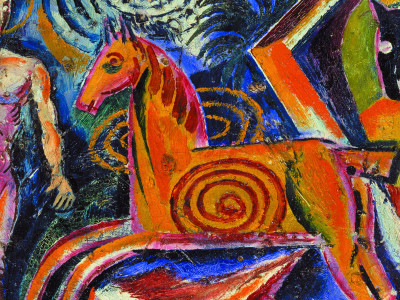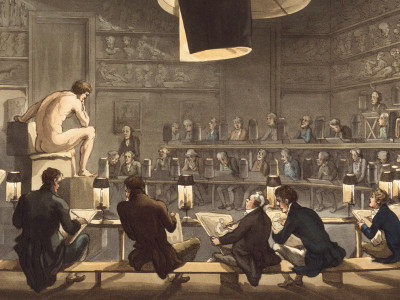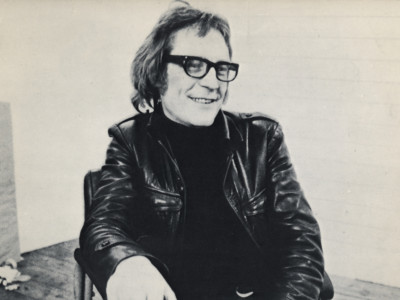
"Do you destroy your work? I do" – Phyllida Barlow and Harrison Birtwistle discuss creativity
By Fiona Maddocks
Published on 15 November 2018
As Phyllida Barlow prepares to open a new show of work at the RA, she joins composer Harrison Birtwistle, and journalist Fiona Maddocks, to exchange ideas about creativity – from how ideas arise to when you know they're finished, and the trauma of titling.
From the Winter 2018 issue of RA Magazine, issued quarterly to Friends of the RA.
The Newcastle-born sculptor Phyllida Barlow RA spent more than 40 years teaching at the Slade School of Art, influencing many younger artists – Rachel Whiteread, Tacita Dean, Conrad Shawcross – but selling very little of her own work and destroying much of it. Her career changed overnight when she won the Paul Hamlyn Award in 2007. Since then she has exhibited at the Serpentine, Tate Britain and the Kunsthalle Zürich. Her sculptures and installations, often brightly coloured, are created from low-grade materials such as cardboard, fabric, plywood, polystyrene and cement. Spreading up and across spaces, they challenge our preconceptions of architecture. In 2011 Barlow was elected a Royal Academician and she represented Great Britain in the 2017 Venice Biennale.
The composer Harrison Birtwistle, born in Accrington, Lancashire, is a leading figure in contemporary music worldwide. He has won international acclaim for his bold and uncompromising works, from music theatre pieces such as Punch and Judy, The Mask of Orpheus, Gawain and The Minotaur, to orchestral scores, including Earth Dances and Exody, to delicate chamber works, many for solo instruments. His new chamber piece for the Nash Ensemble will be premiered at the Wigmore Hall, London, on 12 April 2019. Birtwistle was elected an Honorary Fellow of the Royal Academy of Arts in 1994.
If you want to think about order or disruption of order... A wonderful example is Beethoven. He never does what you think he is going to do. The surprise is perpetual.
Harrison Birtwistle
Fiona Maddocks (FM) Phyllida, first tell us about your new RA exhibition, which will feature a series of large-scale site-specific installations.
Phyllida Barlow (PB) It's called 'cul-de-sac'. Doorways link the three new galleries in Burlington Gardens, so the experience of travelling through the exhibition will be quite controlled. You will have to follow the trajectory from one gallery to another, which will be both interesting and frustrating because, unless there are interventions and surprises, how each gallery is viewed can be a given, where the work will be seen all in one go as a pictorial experience. But I want the work to be traversed in a way that your memory of it is tested – i.e. that you keep forgetting what you've seen. I think that is the nature of sculpture – not something that can be held as a whole image in your head, only as fragments. I also want the space between and above and below the work to become energised in the galleries. The spaces, the silences in between, are as much a component of the work as the thing itself.
FM Why have you chosen Harrison Birtwistle for this conversation?
PB Fabian [the artist Fabian Peake, Barlow's husband] and I have known and loved Harry's work since the 1960s. We went to lots of contemporary music concerts, in part through my sister and her husband [Camilla and Anthony Whitworth-Jones] who are involved with music professionally. There were always people hitting pianos, balloons going off in the middle of a Beethoven string quartet and that sort of thing. There is something in Harry's music, in the way things collide and fall apart, that I can relate to. In his antiphonies for piano and orchestra, there is an extraordinary use of brass instruments – a dense compression of sound that suddenly opens up again into something that is almost about to disappear. It's like making sculpture and never knowing when something is finished.
Harrison Birtwistle (HB) That sounds like my description of what happens with my music.
PB Finishing a work is the hardest thing. There's always something more I want to do. It's a restless activity.
HB There's an old cliché that a work of art is only finished when you take it off the easel. But can I go back to something you said about the continuity of your exhibition, about travelling through it. That's a time element, a key issue in music, and a matter of memory. How far do weremember the order of how a piece goes? I've spent my life trying to make different sorts of continuity, but you can't be self-conscious about it. If you're talking about something you know well – a famous symphony – do you have it in order in your head, or is it a composite thing, like a pack of cards?
PB There's a fascination in trying to remember what constitutes a whole work – music, sculpture. If I said, "Rodin's Kiss", you would be able to give your own description of what it looks like, but there is one view, from the side, where it's just not comprehensible – it's a mix of bits of limbs, arms, stomach. Then we walk round and make it comprehensible again. I see its fixity much like a piece of music.
What I’m scared of is having a belief system, a moral system that sits on my shoulder in judgment saying, 'You haven’t spent long enough on this, you need to graft at this, to show that you have worked.'
Phyllida Barlow RA
HB If you want to think about order, or disruption of order, you have to know what that order was in the first place. A wonderful example is Beethoven. He never does what you think he is going to do. The surprise is perpetual. You know the shape of the music and you think, "How is he going to get out of that bit without a cliché?" Then he does something brilliant. That's his genius.
FM Until Beethoven's time most art, including music, was commissioned for the church or court, so there were the expectations of those patrons.
PB Yes, and I'm always fascinated by that idea of who things are for. I always used to say, "Fuck the audience". I am now trying to grow up about that. When I install a work in a gallery or site, the audience has to relate to it. It's part of the work. When I'm in the studio, the notion of an audience is an encumbrance. The audience is the key element between the private activity of making, and the ultimate, public reveal.
FM Harry, you've been similarly indifferent to audiences. You've encountered noisy protests.
HB I've never had any problem – the problem has been theirs! What has seemed a cul-de-sac for an audience might have been a straight line for me. It seems I have a reputation with audiences but I never calculated things that way.
PB A reputation for being extreme, radical?
HB I don't think you can be extreme. Or original. You can't sit in a room and do that by design. You can only do what you do.
PB I'm quite interested in the difference between convention and tradition. Do you feel part of a tradition?

HB You can't think about tradition. You are part of it, whether you like it or not. Convention is another matter. You can put your finger on that.
PB What would you say tradition is?
HB It has many facets. It's more difficult for me, as a composer, than you. We have a very conservative, very narrow audience in music. It's to do with a convention. In a lot of contemporary music people simply don't know where they are. That's their problem. Yet one of the most radical things in music is András Schiff playing Bach's Preludes and Fugues, one after another in all the different keys. It's about as far out, as mad, as you can get – as well as us sitting down and listening in a way Bach never actually intended.
FM Phyllida, you sometimes work with other people and then the work stands alone. Harry, for you it's the opposite. Your job is solitary, but can only exist when musicians perform it.
HB As a sculptor you have fun. That's one thing. You have the playschool element. It must be wonderful to have all those materials, all those colours. You know what I do? I sit at a table and write hieroglyphics. Nothing more. That's only the beginning. How do you deal with time? I maybe spend three days writing 20 seconds of music. My fundamental problem with this is the excitement of the thing, the inspiration – which is a terrible word – if you want to call it that, has vanished by the second morning.
I always feel in a state of abeyance.
PB I completely, totally, absolutely agree! I've just been working for a month on a piece for a New York show. I have no idea what it is. I mean, I'm not an artist who has ideas. I have reactions and responses. It's a cardboard piece, and it's a horrific work, but I'm intrigued by it. It is leading me. In that sense the playful testing out of things out, not caring, dies a death. Everything that might bolster my confidence, my sense of intuition, has disappeared. For me the time taken has nothing to do with how it ends up.
HB Do you destroy your work? I do.
PB Yes. It was destroyed yesterday in fact, and remade. I quite like the limbo land I'm in at the moment.
HB I can recognise that. I'm the same.
I don't really know what I'm doing most of the time. I get nervous when things feel easy.
Harrison Birtwistle
PB Thinking about time, is there a moral attitude towards the time things take? Is it considered bad if you do things quickly? Do you trust things that happen easily, quickly?
HB I don't really know what I'm doing most of the time. I get nervous when things feel easy. Minimalist music is a problem for me. I wonder what they are doing. Where is the work? Take Gavin Turk's big sculpture of a nail next to St Paul's Cathedral. I'm not against it. I can see the reasons for it. But once he has decided it's going to be a nail, what does he spend his time doing? What is he going to do tomorrow? Conceptually it's wonderful, but what is he going to do tomorrow? The philistine reaction is, "I could have done that". You must come up against that.
PB What I'm scared of is having a belief system, a moral system that sits on my shoulder in judgment saying, "You haven't spent long enough on this, you need to graft at this, to show that you have worked." The Duchamp lineage is different. In Duchamp's fantastic lecture The Creative Act [1957], he talks about the process of transmutation, about things in the world becoming something that has never existed before, like sugar cane being refined to become molasses. I find that very non-judgmental. Unfortunately, Duchamp is used academically, as a prop, where verbal language is prioritised. In the end, that is what I am trying to escape.
FM Do your pieces have titles?
PB My titling is appalling. I just call them things like Untitled Fatty while they're in the studio. As such they are labels not titles.
HB I rather like smart titles. I have a piece I wrote for the pianist Emanuel Ax, called Ax Manual. I've made several pieces that are named after paintings. Melencolia after Dürer, The Triumph of Time after Bruegel. I've been very influenced by Paul Klee. Not so much his painting as his methodology. The way he went back to the beginning again with dots, lines, that sort of thing. By subjecting my intuition to that kind of analysis I could make more of it.
PB I'm curious about how you analyse intuition? What is it dependent on?
HB My ears! If I play a chord at the piano, I can improvise another and it will be alright. But by knowing exactly what the components of the chord are, I can do something more complex and interesting. I can't say why I like certain sounds more than others. It's like saying why you like vanilla ice cream.
PB Things for me are very practical. In the process of making anything, gravity is the most powerful issue. I'm dealing with weight, balance, size, image. I have an obsession with those large advertising hoardings when they fall into disuse and disrepair. I like catching objects when their purpose is no longer apparent. It reflects my way of making.
HB Where would you put an artist like Joseph Beuys?
PB There's always a strong performative element – he combined stories and actions, always busy.
HB He made me look again at things I would think were junk, and they became something else. I spent a week in Scotland once, working in a studio next to Beuys. He put plasma on all the walls, stuck it on, wrote with charcoal on a stick lying on his back. Then halfway through the week he peeled all the plasma off again. People came and watched. That was it.
PB That way of working, where the work is big and space-filling, is an event, and has a very conservative time frame, which is the time of it being on show. So there's no permanence about it. I do make smaller sculptures, and drawings, that I keep.
FM Harry, you make drawings, and you have had some included in the RA Summer Exhibition [Hanging Lines 1, 2004].
HB They are things that only exist in relation to the music I write. They are part of the same thought process as my composition, which is about controlled randomness and chance. I have a game in which I put a small pebble on a sloping board, then roll a pencil towards it – each roll of the pencil, always from the same position, pushes the pebble further. I make a series of marks where the pebble stops. I've chosen the gradient, the pebble and the pencil, but the randomness throws up surprises which intuition, or measurement, never can. Is this nonsense?

PB What I find extraordinary about that is its inventiveness. I don't seek out inventiveness. If it's going to happen it will catch me unawares and will be in the moment of making. I don't have peripheral activities. I have a great envy of what you've just described.
HB But you wouldn't know it was to do with music.
PB You return constantly to a hidden world of the mind, and whether what goes on in the mind does or doesn't reveal itself in the finished work.
HB There's a dichotomy, as I understand your work, between the material you use – wool, cardboard, plaster, plastic – and the finished work.
PB What I'm always trying to find are materials that behave like clay without actually using clay – things that can be easily broken down and built up again. Shapes, objects, things emerge through the actions.
HB There's always something that starts me thinking, a spark – "that's wonderful". But the process of making something is another matter. There's no such thing as a big splash in music. I can do it, musically and technically, but it can take me three weeks. I feel I'm a clock-maker.
PB Yes. That initial engagement with the material is exciting. Then the next day it becomes a slog. Like this work I'm struggling with now – five weeks of cardboard and paint. You would think they were very direct materials.
HB Can I come and help you?
PB Oh yes, yes, please come along!
Fiona Maddocks writes for the Observer and is author of books, including Harrison Birtwistle: Wild Tracks – A Conversation Diary.
Phyllida Barlow RA cul-de-sac Gabrielle Jungels-Wrinkler Galleries, Royal Academy, London, 23 February – 23 June 2019. Friends Previews: 21 February, 10am–6pm; 22 February, 10am-10pm; free; booking required at roy.ac/friendsevents or call 020 7300 8090.

scree, 2013
(Installed at the Des Moines Art Centre, Iowa)

folly, 2017
(Installed in the British Pavilion for the 57th Venice Biennale)

Hanging Lines 1, 2004

demo, 2017
(Installed at Kunsthalle Zürich)
Related articles

Visions from Ukraine
19 June 2024

10 RA Schools stories through the centuries
16 May 2024

In memoriam: Mick Moon RA
1 May 2024
